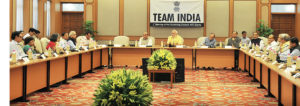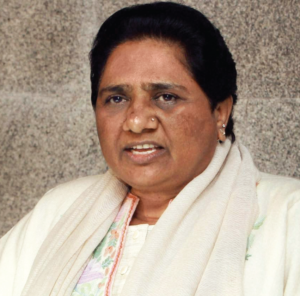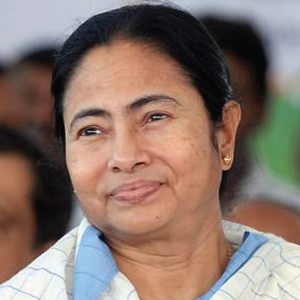The NITI AAYOG aspires to mend the toxic relationship that all Congressruled Central Governments historically had with the states ruled by the opposition parties. How much has it succeeded is anyone’s guess… nirmal k. singh reports
 It is over two years now that the curtains finally fell on the Planning Commission. If one sits to pen down the Constitutional-administrative rights, and other stories about the Planning Commission, it might end up in several volumes and might take a number of weeks to do so. The Planning Commission first came into popular imagination when ex-Prime Minister Rajiv Gandhi made an off the cuff remark about it in a public meeting. “Only 10 paisa reaches to the states of every one rupee released by the Planning Commission,” he had then quipped. Many common voters realised then for the first time how a federal structure works and how the Planning Commission coordinates between the states and the Centre.
It is over two years now that the curtains finally fell on the Planning Commission. If one sits to pen down the Constitutional-administrative rights, and other stories about the Planning Commission, it might end up in several volumes and might take a number of weeks to do so. The Planning Commission first came into popular imagination when ex-Prime Minister Rajiv Gandhi made an off the cuff remark about it in a public meeting. “Only 10 paisa reaches to the states of every one rupee released by the Planning Commission,” he had then quipped. Many common voters realised then for the first time how a federal structure works and how the Planning Commission coordinates between the states and the Centre.
From formulating policies in the Five Year Plans to keeping a tab on how programs are being implemented, the Planning Commission was a great example of the Nehruvian socialism model. It was like a temple; the realisation of a dream. “Pandit Jawaharlal Nehru laid the stone of development through the creation of the Planning Commission. It is because of this foresightedness that India is considered as a power to reckon with in global arena,” says Congress leader Manish Tiwari.
However, not everything was hunky dory. As the Congress Party grew, so did the Planning Commission. It acquired enough power to project itself as a parallel power centre. The post of deputy chairperson became a matter of prestige. It was often given to errant party leaders who needed to be placated. But the quality was hardly compromised. It became so powerful that it was treated as a launch-pad for more powerful postings. Pranab Mukherjee, Madhu Dandwate, Dr Manmohan Singh, Jaswant Singh, K C Pant and Montek Singh Ahluwalia were some of the people who graced the said post.
It was also a matter of demand and supply. As politics became less elite, people with pure political backgrounds started coming in droves, sidelining those who had training in sciences, and came from elite households. Naturally, politicians with such backgrounds tried to preserve the sanctity of the post of the deputy chairperson by making it a bastion of those who had prior relevant training in pure economics or economic management. For a very long period, these deputy chairpersons used to work as a bridge between economic management and pure politicking; but this started to change dramatically in the later days. It reached a point where, during UPA II, Prime Minister Manmohan Singh had to spend considerable time trying to mediate between Montek Singh Ahluwalia and Finance Minister P Chidambaram, who were consistently trying to undercut each other’s positions.
 UPA II had three distinct power centres: 7 Race Course, 10 Janpath and Planning Commission. Rather than trying to balance the other two, Planning Commission was busy promoting pet projects of the Congress. Its focus shifted from coordinating between the states and the Centre to monitoring flagship programs. Consequently, Chief Ministers from non-Congress ruled states started ignoring calls from Yojana Bhawan.
UPA II had three distinct power centres: 7 Race Course, 10 Janpath and Planning Commission. Rather than trying to balance the other two, Planning Commission was busy promoting pet projects of the Congress. Its focus shifted from coordinating between the states and the Centre to monitoring flagship programs. Consequently, Chief Ministers from non-Congress ruled states started ignoring calls from Yojana Bhawan.
Those heydays are behind. Gone are the days when Chief Ministers and their cavalcades used to be a regular feature outside Yojana Bhawan. Every Chief Minister had to come and seek audience from the deputy chairperson of the Planning Commission. Such was the rush that Delhi Police had trouble sorting out the traffic in that area. Those days are gone. The building remains the same, but the crowd has melted. It bears a desolate look as it awaits VIP guests, if at all.
The abolishment of the Planning Commission was one of the first major decisions of the Narendra Modi Government. It was replaced by Niti Aayog. A cleaver play of words in both Hindi and English, Niti expands into National Institution for Transforming India, stands for policy in Hindi. It was established through a proposal passed through a Cabinet meeting, a tradition that has been followed in the past too. Modi had called the Planning Commission a remnant of the past and a threat to the federal structure. Congress-ruled states opposed the move and said that it was a below-the-belt step to erase the tradition of the Nehru-Gandhi family and the tradition of Nehruvian socialism. They also alleged that it was a cunning way of concentrating all the power to the PMO.
Ex-Prime Minister Manmohan Singh said that by abolishing the Planning Commission, the country has lost its developmental trajectory.
However, Arun Maira, who was a member of the Planning Commission, maintains that the Planning Commission lost its relevance after the liberalisation of 1991. At least, in its current last form without any changes. Similar sentiments were expressed by another ex-member Sompal Shashtri. Many of the detractors consider that the Planning Commission was reduced to the whims of individuals rather than acting as an institution.


 When Prime Minister Modi abolished the body and brought in Niti Aayog, one of his primary reasons was the adverse effect that the Planning Commission had on the Centre-state relationship.
When Prime Minister Modi abolished the body and brought in Niti Aayog, one of his primary reasons was the adverse effect that the Planning Commission had on the Centre-state relationship.
He listed some of the problems that he had to face as a Chief Minister. State governments had to come to the Planning Commission to get their budgets approved, which was to be used under planned expenditure. Any program needed to get the nod of approval from the body, which also kept a vigil on the project. There was hardly any decision that a ministry could take independently. Every decision needed to have approval from the Planning Commission. Although this sounds more cumbersome than it really was, the approvals were not very hard to get.
But at times, the Commission used to withhold the approval on technical reasons. It received considerable flak for being inconsiderate. Needless to say, Narendra Modi’s relationship with the Planning Commission was at its lowest during the ten years of UPA rule.
Modi started to target the body rather publicly. Even during the meetings of the National Development Council, it was almost customary for the Chief Ministers from BJP and Congress-held states to criticise each other in the most intense of languages. J Jayalalitha, Chief Minister of Tamilnadu, is known to have come down heavily on the body. Mayawati never paid a visit to the Planning Commission; and neither did Mamata Banerjee.
 When Niti Aayog came into existence, it took the Prime Minister six months to appoint a deputy chairperson and three permanent members. There were some changes in nomenclature as well. The Secretary is now called the CEO. But like its predecessor, the Prime Minister remains the Chairperson of the body. A Governing Council has also been constituted. It has curiously been named “Team India.” It consists of the Chief Ministers of all the states and lieutenant-governors of the Union Territories as members.
When Niti Aayog came into existence, it took the Prime Minister six months to appoint a deputy chairperson and three permanent members. There were some changes in nomenclature as well. The Secretary is now called the CEO. But like its predecessor, the Prime Minister remains the Chairperson of the body. A Governing Council has also been constituted. It has curiously been named “Team India.” It consists of the Chief Ministers of all the states and lieutenant-governors of the Union Territories as members.
It was said during its institution that Niti Aayog will provide developmental agenda for the Prime Minister and the Chief Ministers, as “it takes strong states to form a strong nation.” The idea was to strengthen the concept of cooperative federalism. The commission will also coordinate with academic and intellectual bodies from India and the world. It will also remain in touch with various educational and policy oriented research institutes.
Niti Aayog has been established in close consultations with states, experts from various fields as well as heads of various relevant institutions. Its major work is to offer strategic suggestions, guidelines and recommendations related to administrative affairs and increased use of technology in the economy. It has to work as an incubator for new ideas to efficiently run administration. In consultation with states, it needs to develop a common agenda for development. It has to come up with mechanisms which can develop effective programs at village levels, and which can be seamlessly integrated at the highest level. Strategic planning and security interests are some of the priorities that this body will keep in mind during policy formulation. It is also expected that the focus shall be on that section of the society, which is vulnerable and misses out on the benefits of economic development.
N K Singh, ex-member of Planning Commission and a senior leader of BJP says, “Those things that were considered untouchable by Congress, have been taken up by Modi Government in its endeavour to change the country. This includes programs like Clean India as well as the vision to include urbanisation as a growth engine for economic development. The basis behind this is to improve the lives of the people by tending to their basic needs and providing infrastructure for the same. This was the basis of the Planning Commission. Prime Minister Modi had committed to fulfil this, and that is what he is doing. This is why his popularity among the people is increasing.”

 To some, these merely sound as clichés. Detractors mention that in the one and a half years of Niti Aayog’s performance, it has hardly anything to show and that it has hardly anything to do. There is some weight in this. The Planning Commission had a lot of say in the budget formulation in the past. But the Modi Government has given the duty of finalising planned expenditure to the Finance Ministry. The number of centre-sponsored projects has been trimmed down from 250 to 9. Those that have not been curtailed have been directly handed over to the related ministries. State governments have been allowed to decide their own budgets. A certain level of flexibility has also been introduced in order to let states spend funds allocated for projects initiated by the Central Government. Basically, Niti Aayog has pretty little left to do.
To some, these merely sound as clichés. Detractors mention that in the one and a half years of Niti Aayog’s performance, it has hardly anything to show and that it has hardly anything to do. There is some weight in this. The Planning Commission had a lot of say in the budget formulation in the past. But the Modi Government has given the duty of finalising planned expenditure to the Finance Ministry. The number of centre-sponsored projects has been trimmed down from 250 to 9. Those that have not been curtailed have been directly handed over to the related ministries. State governments have been allowed to decide their own budgets. A certain level of flexibility has also been introduced in order to let states spend funds allocated for projects initiated by the Central Government. Basically, Niti Aayog has pretty little left to do.
Another BJP leader and ex-member of the Planning Commission, Sompal Singh Shastri says, “We must appreciate the vision of Modiji. Especially the Clean India campaign and the campaign for urbanization. These, along with the Minimum Support Price for agriculture products, and clear roadmap for the achieving of Sustainable Development Goals by 2030, are some of the exemplary work done by Modiji. These were some of the issues that were considered demeaning for the Congress Party. As an ex-member of the Planning Commission, I had requested the body to focus on the depleting ground water in Western UP, but I didn’t receive so much as an acknowledgement letter from it. In contrast, Niti Aayog is focusing on even the minutest of problems. We are very positive about its success.”
There are only two major works that Niti Aayog has indulged itself into. First is to create an outline of the Sustainable Development Goal (SDG) in the place of the Millennium Development Goal (MDG). The second is to come to a conclusion about what to do when the 12th Five Year Plan comes to an end. What direction will the country take after the completion of the 12th Five Year Plan, was a big question. The Commission has come up with three separate proposals. One of the proposals is to extend the same goals for a longer period, which have been finalised by the Modi Government for its Sustainable Development Goal till the year 2030. This is in accordance with the Millennium Development Goals finalised by the United Nations. The Commission was also asked to finalise 17 goals and the roadmap of its realisation through relevant ministries. This has already been fulfilled by the Commission. Among the finalised goals under SDG, the first and the foremost is to eradicate all sorts of poverty by the year 2030. Niti Aayog’s roadmap is confident that poverty of all sorts will be eradicated by the year 2030.
For this, as many as five programs, including the National Rural Livelihood Mission and MANREGA, have been earmarked. As many as nine ministries will be involved in the implementation process. Similarly, to eradicate hunger-deaths, the National Food Security Program, Mid-Day Meals and seven other programs have been earmarked through seven different ministries. Quality of life, better education, eradication of gender-bias and availability of electricity to all are some of the other targets. The second proposal is to form a long term program. This program will include the National Development Agenda, which will run till 2023-24. There will be a mid-term assessment in three years’ time. The third proposal is to form a three years’ plan which will complete its goals by the end of the tenure of the 14th Finance Commission by the year 2019-2020. Its primary focus is to spread out its achievement for the voters who will vote in the 2019 elections.
Cabinet Minister Mukhtar Abbas Naqvi says, “When we say Congress-free India, what we mean is what BJP President Amit Shah has so eloquently explained – that is to eradicate elements of Congress-like functioning, to eradicate those problems that the Congress ignored. This slogan is against that mentality that puts the individual before the country.”
An ex-bureaucrat maintains that the basic idea behind this body was to redefine the Centre-state relations by taking state governments into confidence.
“The relationship had deteriorated to such a level during UPA II that Chief Ministers from non-UPA states stopped going to the Planning Commission altogether. Not that states that had UPA governments had any better luck. States had to beg to gets funds released for the Centrally funded schemes. Niti Aayog will monitor, coordinate and ensure implementation of the globally accepted Sustainable Development Goals. It has also been nominated as the nodal body that will bring the 17 development goals into action across India. The SDGs are aimed at eradicating all forms of poverty,” he added to good measure.
There are contrasting opinions of the performance of NitiAayog in its lifetime of a year and a half. The jury is still out. It will probably take some years before a clear judgement can be passed on its functioning. For now, all seems well.
























